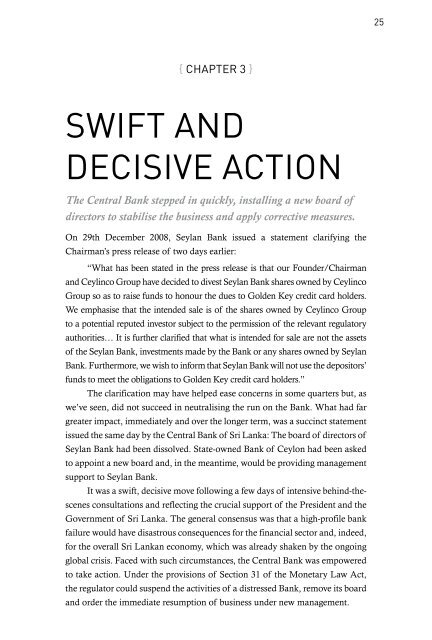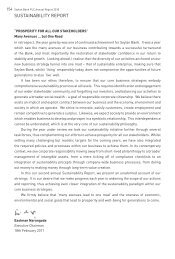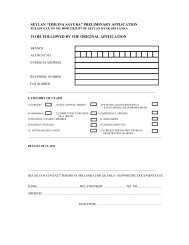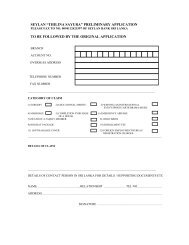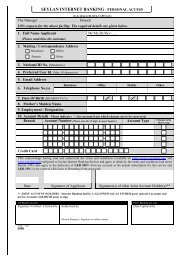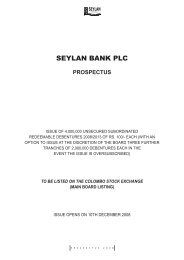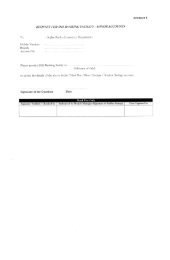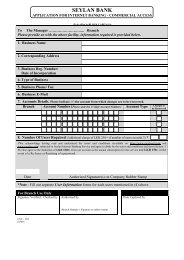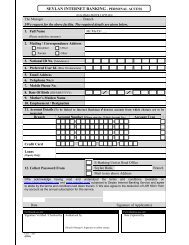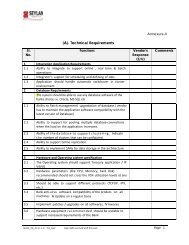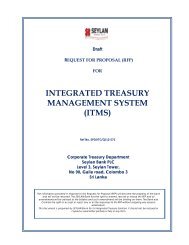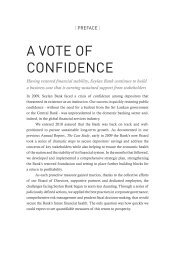- Page 4: The Case Study > Seylan Bank PLC An
- Page 8 and 9: Copyright © 2009 Seylan Bank PLCSt
- Page 13 and 14: 9{ Chapter 1 }Growth and ItsChallen
- Page 15 and 16: Growth and Its Challenges11Rapid, P
- Page 17 and 18: Growth and Its Challenges13“Despi
- Page 19: Growth and Its Challenges15The comp
- Page 22 and 23: 18The Case Study > Seylan Bank PLC
- Page 30 and 31: 26The Case Study > Seylan Bank PLC
- Page 32 and 33: 28The Case Study > Seylan Bank PLC
- Page 34 and 35: 30the board of DIRECTORSThe Case St
- Page 37: Swift and Decisive Action33Mr. Nara
- Page 40 and 41: 36The Case Study > Seylan Bank PLC
- Page 42 and 43: 38The Case Study > Seylan Bank PLC
- Page 45 and 46: 41{ Chapter 5 }Rebuildingthe Busine
- Page 47 and 48: Rebuilding the Business43• To sup
- Page 49 and 50: Rebuilding the Business45definitely
- Page 51: Rebuilding the Business47The public
- Page 54 and 55: 50The Case Study > Seylan Bank PLC
- Page 56: 52The Case Study > Seylan Bank PLC
- Page 59 and 60: 55BENCHMARKS OFSUCCESSThe ultimate
- Page 61 and 62: Seylan Bank PLC Annual Report 2009
- Page 63 and 64: Seylan Bank PLC Annual Report 2009
- Page 65: Seylan Bank PLC Annual Report 2009
- Page 68 and 69: 64Seylan Bank PLC Annual Report 200
- Page 70 and 71: 66Seylan Bank PLC Annual Report 200
- Page 72 and 73: 68Seylan Bank PLC Annual Report 200
- Page 74 and 75:
70Seylan Bank PLC Annual Report 200
- Page 76 and 77:
72Seylan Bank PLC Annual Report 200
- Page 78 and 79:
74Seylan Bank PLC Annual Report 200
- Page 80 and 81:
76Seylan Bank PLC Annual Report 200
- Page 82 and 83:
78Seylan Bank PLC Annual Report 200
- Page 84 and 85:
80Seylan Bank PLC Annual Report 200
- Page 86 and 87:
82Seylan Bank PLC Annual Report 200
- Page 88 and 89:
84Seylan Bank PLC Annual Report 200
- Page 90 and 91:
86Seylan Bank PLC Annual Report 200
- Page 92 and 93:
88Seylan Bank PLC Annual Report 200
- Page 94 and 95:
90Seylan Bank PLC Annual Report 200
- Page 96 and 97:
92Seylan Bank PLC Annual Report 200
- Page 98 and 99:
94Seylan Bank PLC Annual Report 200
- Page 100 and 101:
96Seylan Bank PLC Annual Report 200
- Page 102 and 103:
98Seylan Bank PLC Annual Report 200
- Page 104 and 105:
100Seylan Bank PLC Annual Report 20
- Page 106 and 107:
102Seylan Bank PLC Annual Report 20
- Page 108 and 109:
104Seylan Bank PLC Annual Report 20
- Page 110 and 111:
106Seylan Bank PLC Annual Report 20
- Page 112 and 113:
108Seylan Bank PLC Annual Report 20
- Page 114 and 115:
110Seylan Bank PLC Annual Report 20
- Page 116 and 117:
112Seylan Bank PLC Annual Report 20
- Page 118 and 119:
114Seylan Bank PLC Annual Report 20
- Page 120 and 121:
116Seylan Bank PLC Annual Report 20
- Page 123 and 124:
Seylan Bank PLC Annual Report 2009
- Page 125 and 126:
Seylan Bank PLC Annual Report 2009
- Page 127 and 128:
Seylan Bank PLC Annual Report 2009
- Page 129 and 130:
Seylan Bank PLC Annual Report 2009
- Page 131 and 132:
Seylan Bank PLC Annual Report 2009
- Page 133 and 134:
Seylan Bank PLC Annual Report 2009
- Page 135 and 136:
Seylan Bank PLC Annual Report 2009
- Page 137 and 138:
Seylan Bank PLC Annual Report 2009
- Page 139 and 140:
Seylan Bank PLC Annual Report 2009
- Page 141 and 142:
Seylan Bank PLC Annual Report 2009
- Page 143 and 144:
Seylan Bank PLC Annual Report 2009
- Page 145 and 146:
Seylan Bank PLC Annual Report 2009
- Page 147 and 148:
Seylan Bank PLC Annual Report 2009
- Page 149 and 150:
Seylan Bank PLC Annual Report 2009
- Page 151 and 152:
Seylan Bank PLC Annual Report 2009
- Page 153 and 154:
Seylan Bank PLC Annual Report 2009
- Page 155 and 156:
Seylan Bank PLC Annual Report 2009
- Page 157 and 158:
Seylan Bank PLC Annual Report 2009
- Page 159 and 160:
Seylan Bank PLC Annual Report 2009
- Page 161 and 162:
Seylan Bank PLC Annual Report 2009
- Page 163 and 164:
Seylan Bank PLC Annual Report 2009
- Page 165 and 166:
Seylan Bank PLC Annual Report 2009
- Page 167 and 168:
Seylan Bank PLC Annual Report 2009
- Page 169 and 170:
Seylan Bank PLC Annual Report 2009
- Page 171 and 172:
Seylan Bank PLC Annual Report 2009
- Page 173 and 174:
Seylan Bank PLC Annual Report 2009
- Page 175 and 176:
Seylan Bank PLC Annual Report 2009
- Page 177 and 178:
Seylan Bank PLC Annual Report 2009
- Page 179:
Seylan Bank PLC Annual Report 2009
- Page 182 and 183:
178Seylan Bank PLC Annual Report 20
- Page 184 and 185:
180Seylan Bank PLC Annual Report 20
- Page 186 and 187:
182Seylan Bank PLC Annual Report 20
- Page 188 and 189:
184Seylan Bank PLC Annual Report 20
- Page 190 and 191:
186Seylan Bank PLC Annual Report 20
- Page 192 and 193:
188Seylan Bank PLC Annual Report 20
- Page 194 and 195:
190Seylan Bank PLC Annual Report 20
- Page 196 and 197:
192Seylan Bank PLC Annual Report 20
- Page 198 and 199:
194Seylan Bank PLC Annual Report 20
- Page 201 and 202:
Seylan Bank PLC Annual Report 2009
- Page 203 and 204:
Seylan Bank PLC Annual Report 2009
- Page 205 and 206:
Seylan Bank PLC Annual Report 2009
- Page 207 and 208:
Seylan Bank PLC Annual Report 2009
- Page 209 and 210:
Seylan Bank PLC Annual Report 2009
- Page 211 and 212:
Seylan Bank PLC Annual Report 2009
- Page 213 and 214:
Seylan Bank PLC Annual Report 2009
- Page 215 and 216:
Seylan Bank PLC Annual Report 2009
- Page 217 and 218:
Seylan Bank PLC Annual Report 2009
- Page 219 and 220:
Seylan Bank PLC Annual Report 2009
- Page 221 and 222:
Seylan Bank PLC Annual Report 2009
- Page 223 and 224:
Seylan Bank PLC Annual Report 2009
- Page 225 and 226:
Seylan Bank PLC Annual Report 2009
- Page 227 and 228:
Seylan Bank PLC Annual Report 2009
- Page 229 and 230:
Seylan Bank PLC Annual Report 2009
- Page 231 and 232:
APPENDIXProfiles of the Board of Di
- Page 233 and 234:
Seylan Bank PLC Annual Report 2009
- Page 235 and 236:
Seylan Bank PLC Annual Report 2009
- Page 237 and 238:
Seylan Bank PLC Annual Report 2009
- Page 239 and 240:
Seylan Bank PLC Annual Report 2009
- Page 241 and 242:
Seylan Bank PLC Annual Report 2009
- Page 243 and 244:
Seylan Bank PLC Annual Report 2009
- Page 245 and 246:
Seylan Bank PLC Annual Report 2009
- Page 247 and 248:
Seylan Bank PLC Annual Report 2009
- Page 249 and 250:
Seylan Bank PLC Annual Report 2009
- Page 251 and 252:
Seylan Bank PLC Annual Report 2009
- Page 253 and 254:
Seylan Bank PLC Annual Report 2009
- Page 255 and 256:
fi,dka nexl=j mS't,a'iS' ys 2009 jd
- Page 257:
nryhd; tq;fp gpvy;rp Mz;lwpf;if 200
- Page 260 and 261:
256Seylan Bank PLC Annual Report 20


